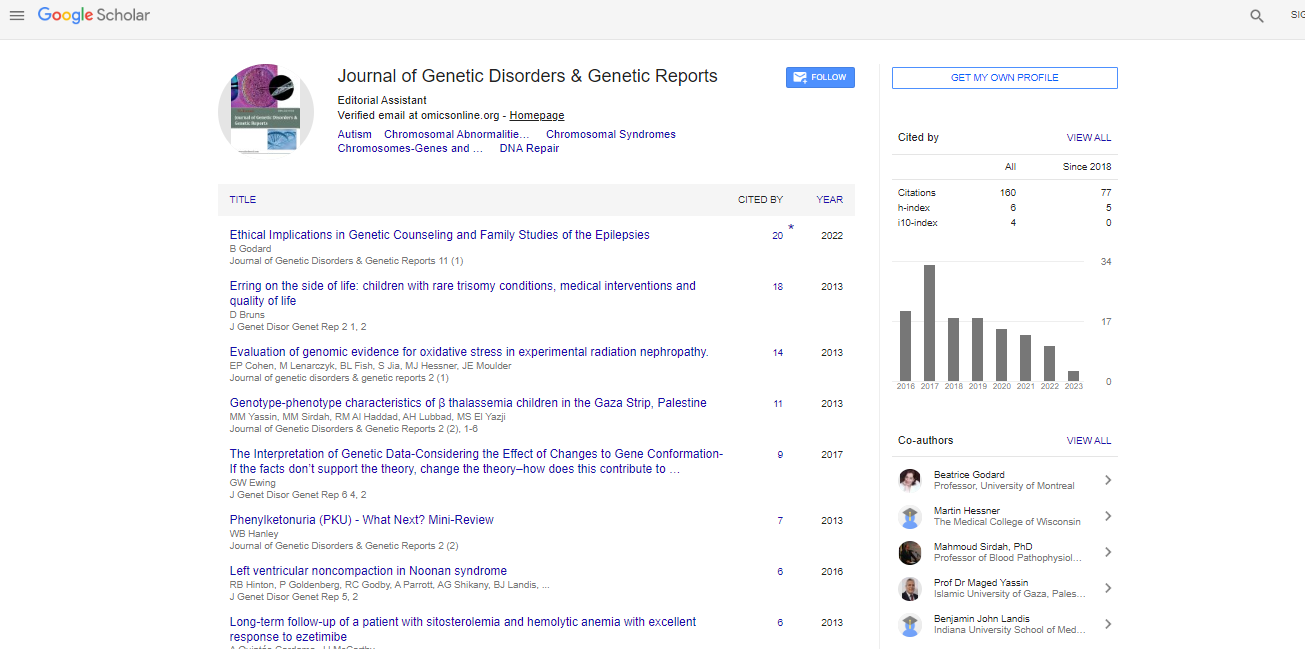Opinion Article, Vol: 12 Issue: 1
The Role of Chromosomes in Inheritance and Genetic Diversity
Amine Bechar*
College of Life Science and Technology, Huazhong Agricultural University, Wuhan, Hubei 430070, China.
*Corresponding Author: Amine Bechar,
Amine Bechar, College of Life Science and Technology, Huazhong Agricultural University, Wuhan, Hubei 430070, China;
E-mail: AmineBechar@mail.hzau.edu
Received date: 25 January, 2023, Manuscript No. JGDGR-23-92054;
Editor assigned date: 27 January, 2023, Pre QC No. JGDGR-23-92054(PQ);
Reviewed date: 13 February, 2023, QC No. JGDGR-23-92054;
Revised date: 20 February, 2023, Manuscript No. JGDGR-23-92054(R);
Published date: 27 February, 2023, DOI: 10. 4172/2576-1439.1000193
Citation: Bechar A (2023) The Role of Chromosomes in Inheritance and Genetic Diversity. J Genet Disor Genet Rep 12:1.
Description
Chromosomes play an important role in inheritance because they carry an organism's genetic information in the form of DNA. When cells divide, chromosomes are replicated and passed on to the daughter cells, ensuring that each new cell has a complete set of genetic information.
In humans, each cell typically contains 23 pairs of chromosomes, for a total of 46 chromosomes. One set of chromosomes is inherited from the mother and the other set from the father. The 23rd pair of chromosomes is the sex chromosomes, which determine an individual's biological sex. Females have two X chromosomes, while males have one X and one Y chromosome. The specific location of a gene on a chromosome is called a locus, and different versions of a gene are called alleles. Inheritance of a particular trait depends on the combination of alleles inherited from both parents. For example, if a person inherits two copies of the same allele for a particular trait, they are said to be homozygous for that trait. If they inherit two different alleles, they are said to be heterozygous.
The inheritance pattern of a trait depends on the location of the gene on the chromosome and whether the allele is dominant or recessive. Dominant alleles are expressed when present in either one or both copies, while recessive alleles are only expressed when present in both copies. Some traits, such as eye colour, are determined by multiple genes located on different chromosomes. In these cases, inheritance patterns can be more complex and may involve interactions between multiple genes.
Overall, chromosomes play an important role in inheritance by carrying an organism's genetic information and determining the expression of traits through the inheritance of alleles. Genetic diversity refers to the variation in the genetic makeup of individuals within a population or a species. This variation arises from differences in the DNA sequences of genes, which can result in differences in physical, physiological, and behavioural traits. Genetic diversity is important because it enables populations to adapt to changing environments and to resist diseases and other threats. Populations with higher genetic diversity are generally more resilient and have a greater ability to respond to environmental changes.
Several factors that can contribute to genetic diversity
Mutation: Mutations are changes in the DNA sequence that can create new alleles or modify existing ones.
Genetic recombination: Genetic recombination occurs during meiosis, when the chromosomes from each parent are shuffled and recombined to create new combinations of alleles.
Gene flow: Gene flow occurs when individuals or gametes from one population migrate to another population, introducing new alleles into the gene pool.
Genetic drift: Genetic drift occurs when random events, such as natural disasters or population bottlenecks, cause changes in the frequency of alleles in a population.
Natural selection: Natural selection favors individuals with traits that increase their survival and reproductive success, leading to changes in allele frequencies over time.
Maintaining genetic diversity is important for the long-term survival of populations and species. Human activities, such as habitat destruction, pollution, and overexploitation, can reduce genetic diversity by reducing population sizes and limiting gene flow. Conservation efforts, such as habitat restoration, captive breeding programs, and genetic management, can help to maintain and restore genetic diversity in threatened and endangered species.
 Spanish
Spanish  Chinese
Chinese  Russian
Russian  German
German  French
French  Japanese
Japanese  Portuguese
Portuguese  Hindi
Hindi 



